Take a closer look at some of the threatened and endangered species that call the South Carolina Lowcountry home
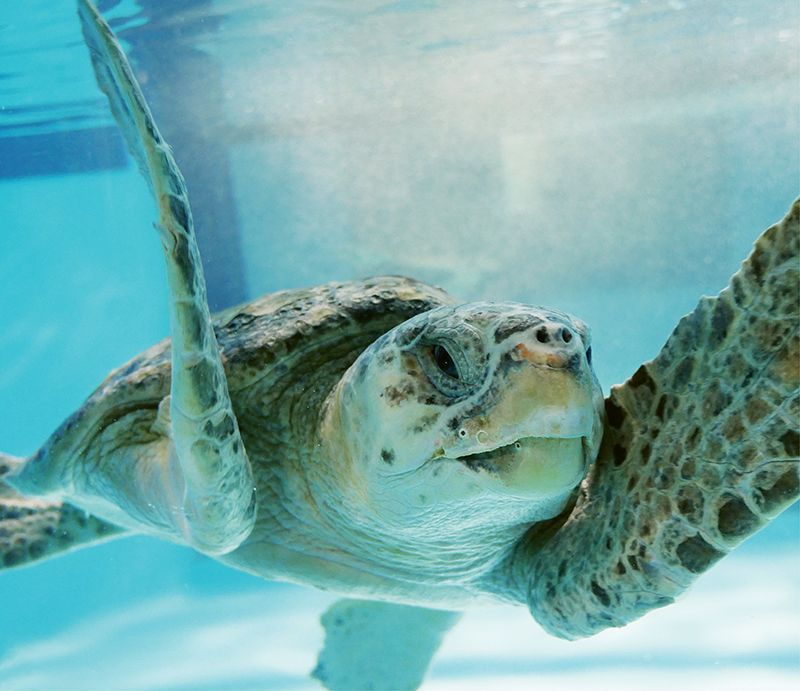
Sea turtle nests in South Carolina are counted and protected by a large team of volunteers up and down the coast. Find a volunteer group near you at dnr.sc.gov/seaturtle.
The Lowcountry hosts a remarkable variety of plants and animals. Some, like the monarch butterfly and swallow-tailed kite, undertake Herculean migrations each year, using our corner of the world as an important stopping point along the way. Many others—reptiles like the flatwoods salamander and plants such as the Venus flytrap—are endemic to unique ecosystems of the Southeast and found nowhere else on the planet. But due to diminishing habitat along our barrier island coastline and in longleaf pine forests, a number of species are considered “threatened” or “endangered.” Learn more about these fascinating creatures, what’s being done to protect them, and how you can help.
Loggerhead Sea Turtle (Caretta caretta)
Status: State threatened and federally threatened
South Carolinians love sea turtles—so much so that loggerheads are enshrined in the code of laws as the state reptile. Large and ungainly out of water, loggerheads return to state beaches each spring and summer to lay their eggs in deep pits along the sandy shore. South Carolina is also home to three other endangered sea turtles—the green, Kemp’s ridley, and leatherback—all of which have suffered declines due to loss of nesting habitat, poaching, and fishing practices. Since the 1980s, our state has been a pioneer in sea turtle conservation, starting with the development of turtle excluder devices that have prevented thousands of animals from drowning in fishing nets. These days, loggerhead nest numbers are on the rise across the Southeast; however, as human populations soar along the coast, so too do man-made dangers such as collisions with boat propellers.
Watch Hank's journey home:

Range: Found worldwide in subtropical to temperate regions of the Mediterranean Sea and Pacific, Indian, and Atlantic oceans
--------------------

Destruction of habitat due to logging and development is the primary threat to these endangered amphibians.
Frosted Flatwoods Salamander (Ambystoma cingulatum)
Status: State endangered and federally threatened
The palm-sized flatwoods salamander, one of the rarest amphibians in our region, leads a solitary, underground existence punctuated only by the occasional mass excursion to breeding ponds as far as a mile away. The adults, covered in a “frosted,” lichen-like patterning, inhabit root channels and crayfish burrows, increasing the difficulty of studying and tracking the amphibians, whose survival depends on the native longleaf pine savannas in which they live. Recent South Carolina Department of Natural Resources (SCDNR) surveys have located only one or two salamanders at a time in just two counties: Berkeley and Jasper.

Range: The lower Southeastern Coastal Plain of the US
------------------

The bat forages for insects, especially moths and mosquitoes, for several hours after dark; Due to its wide distribution, IUCN Red List categorizes the species as being of “least concern.” However, four states (Georgia, West Virginia, South Carolina, and Tennessee) have reported population declines, and populations in Indiana and Ohio likely have been eradicated.
Rafinesque’s Big-Eared Bat (Corynorhinus rafinesquii)
Status: State endangered
If you’re no fan of mosquitoes and moths, you should find a friend in the Rafinesque’s big-eared bat. These tiny mammals with comically large ears emerge after sundown to snatch up soft-bodied insects, ridding us of pests free of charge. Although these mammals are difficult to study, South Carolina experts believe big-eared bat numbers have dropped precipitously. One reason is that the large, ancient trees with prime roosting cavities that are in areas undisturbed by humans have become difficult to find. But the bats will also make do with abandoned buildings and even bridge trusses, providing some alternatives that have proven promising in the quest to restore their numbers.
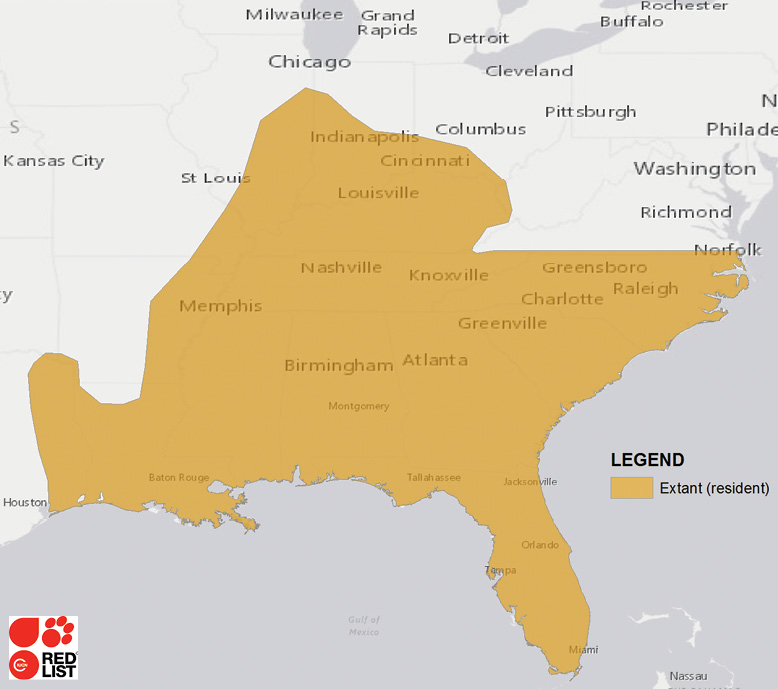
Range: Throughout the South Central and Southeastern US
------------------
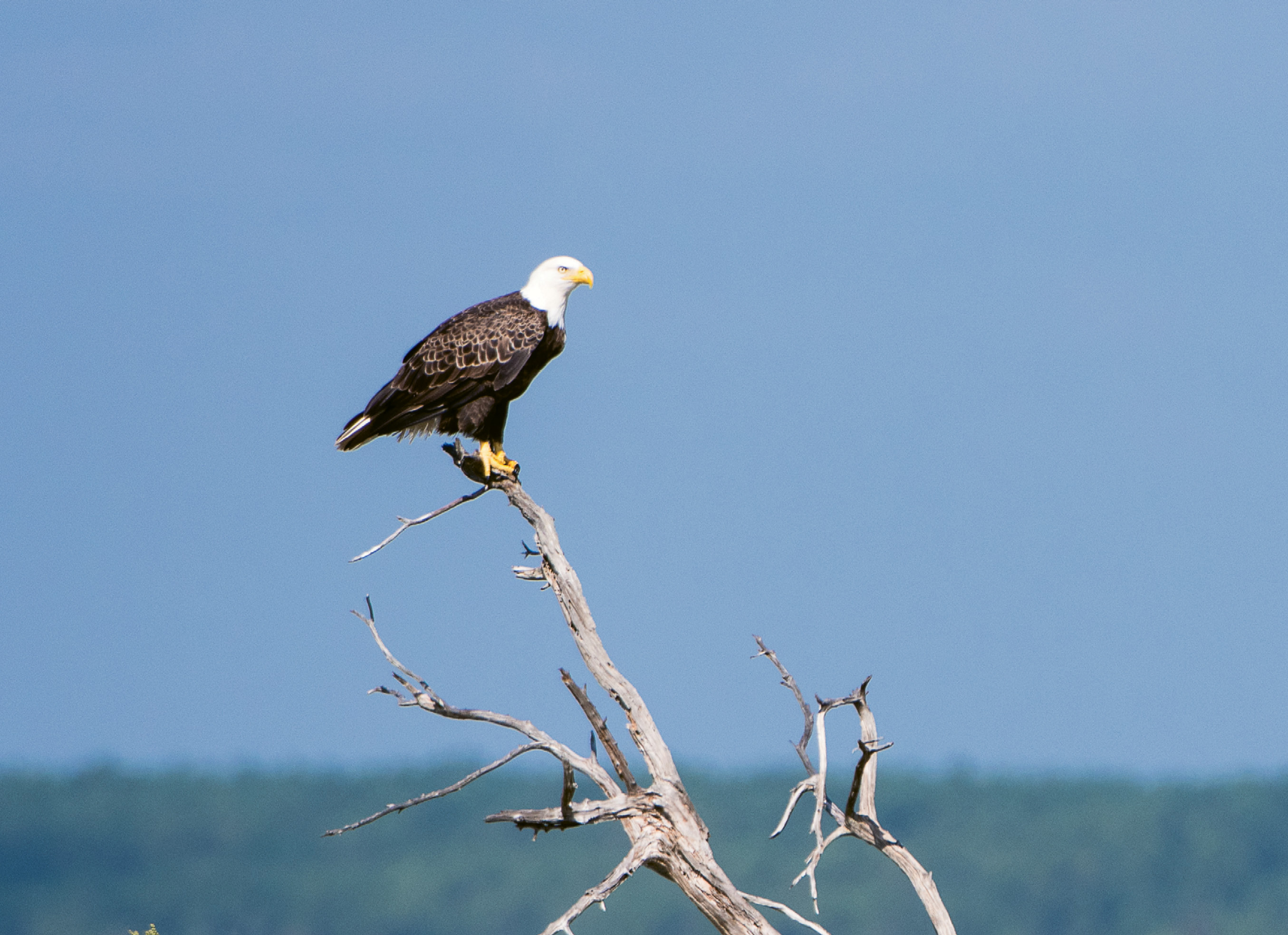
A wild eagle in Cape Romain National Wildlife Refuge near Bulls Island; Learn more about the Center for Birds of Prey and how you can help at thecenterforbirdsofprey.org.
Bald Eagle (Haliaeetus leucocephalus)
Status: State threatened
Its near extinction became a clarion call for wildlife protections in the mid-20th century, and the snowy-headed bald eagle has since become one of the movement’s greatest successes, thanks in large part to the outlaw of pesticide DDT. From a low of just a few dozen birds, South Carolina’s bald eagles now number more than 400 nesting pairs. The American icon is more pirate than true predator, a scavenger who prefers robbing abler hunters—like the osprey—or settling for carrion. You’ll spot bald eagles statewide but mostly along the coast near waterways and atop enormous nests in craggy pine tops.
Watch a video about the center
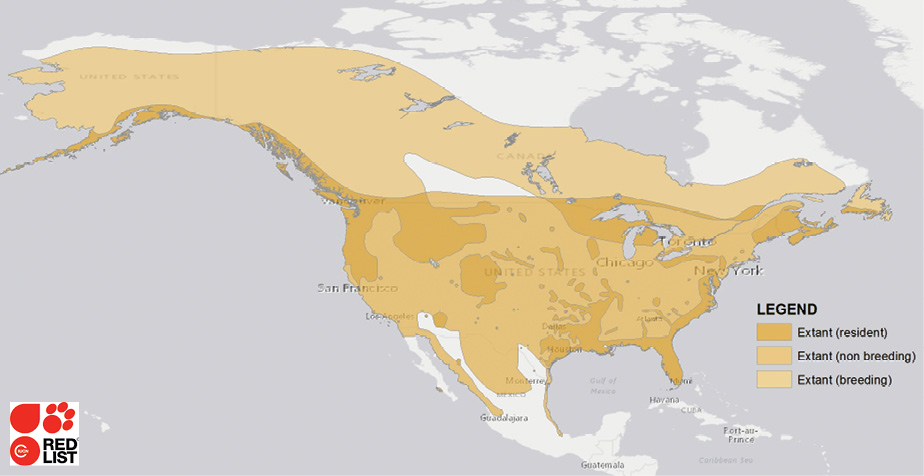
Range: North America, as well as Saint Pierre, Miquelon, Belize, Bermuda, Ireland, Puerto Rico, and the US Virgin Islands
--------------------

Locally, swallow-tailed kites are primarily spotted in large floodplain forests and swamps of the outer coastal plain, especially in the Francis Marion National Forest and on the Santee, Edisto, and Savannah rivers; With a former breeding ground that included 21 states as far north as Minnesota, the swallow-tailed kite is now limited to seven or eight Southern states. Help South Carolina and the Center for Birds of Prey monitor their distribution and population trends by reporting sightings at thecenterforbirdsofprey.org.
Swallow-Tailed Kite (Elanoides forficatus)
Status: State endangered
The arrival of swallow-tailed kites in South Carolina each spring is one of the most anticipated birding events of the year. Flying astounding distances from Central and South America, these much-loved kites annually seek out the same forested areas, where they build nests and raise their young in towering pine tops. Many have argued the birds of prey are unparalleled in beauty and grace, gliding aloft on velvet-black wings with rarely a flap as they hunt cicadas, lizards, and wasps. Swallow-tailed kites are vulnerable to numerous threats across their long migration routes and will require truly hemispheric cooperation to protect.
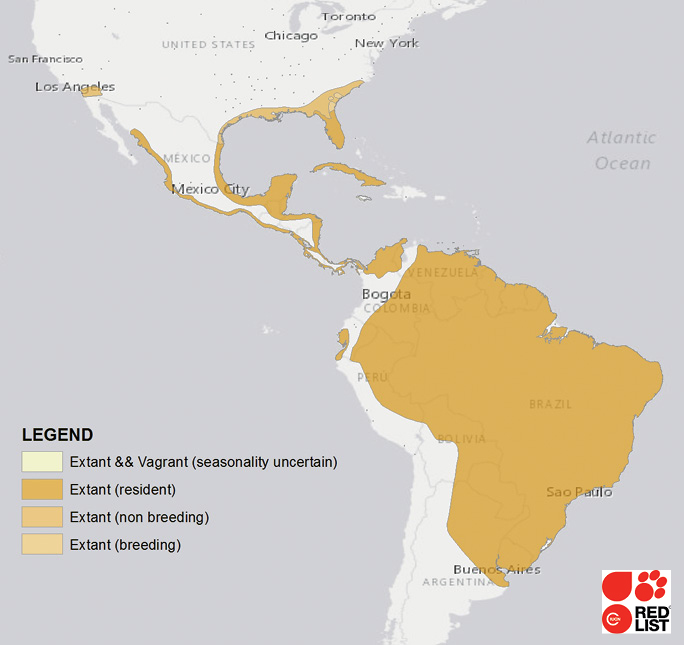
Range: From the Southeastern US to southern Brazil
------------------
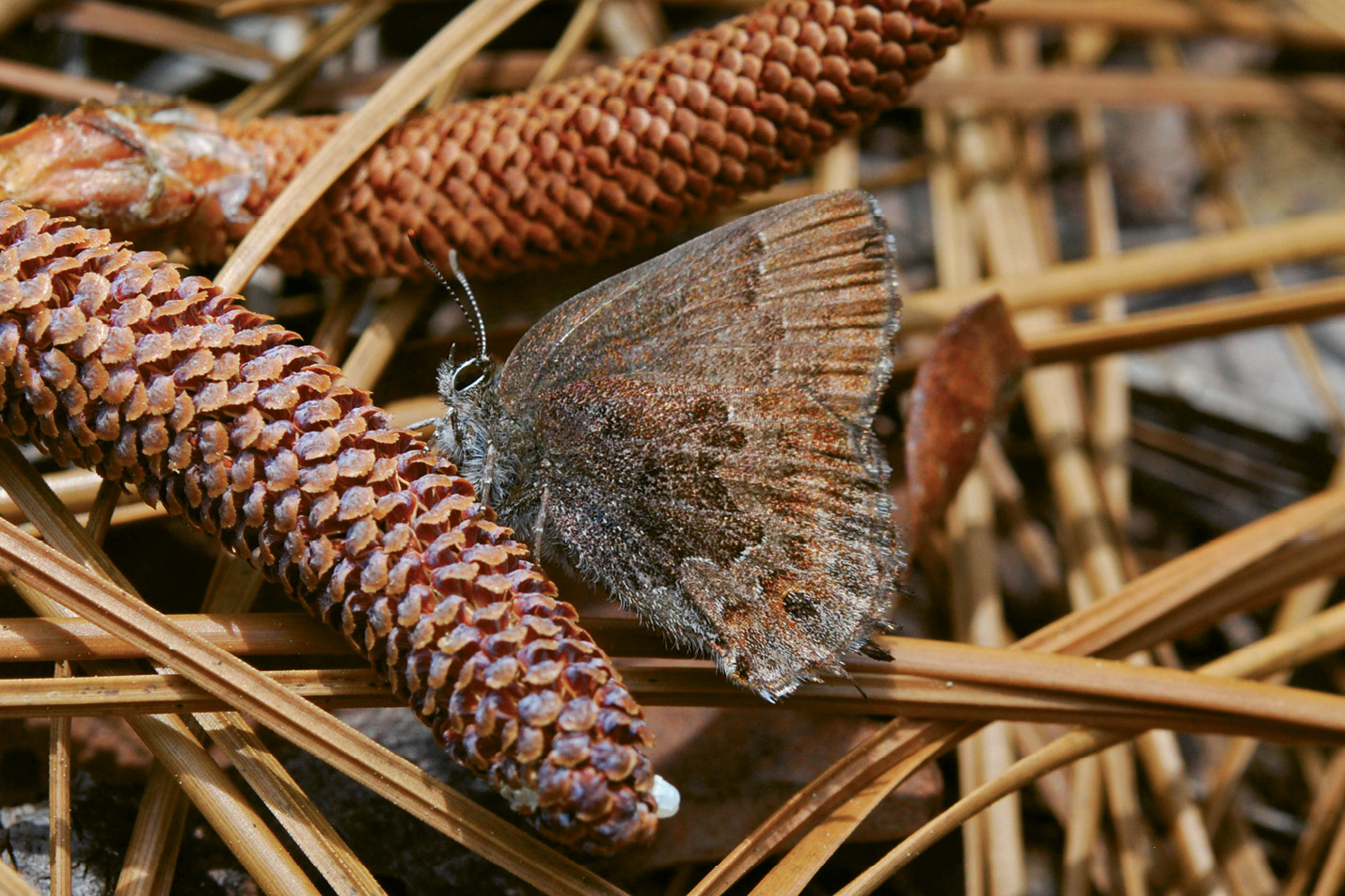
Help pollinators like the frosted elfin by using native plants in your landscaping and avoiding insecticides, which can kill good insects in addition to pests; Range: Widespread distribution across the eastern half of the US but rare in all areas
Frosted Elfin (Callophrys irus)
Status: Under consideration for federal protection
Just an inch wide, the frosted elfin butterfly has a downy body and gray-brown wings edged in white, as if brushed by frost. What the milkweed is to monarchs, wild indigo and lupine are to frosted elfins; their survival depends on these native plants. But unlike the monarch, these tiny pollinators are homebodies, spending their lives in small patches of open woods, never straying too far from their host plants. Habitat loss has led to the disappearance of the frosted elfin across much of its range, leading the US Fish and Wildlife Service to consider it for protections under the Endangered Species Act.
-----------

Biologists believe fire ants may play a role in the decline of this species, whose eggs are vulnerable to the invasive insects. Learn more about the snakes of South Carolina at srelherp.uga.edu/snakes.
Southern Hognose Snake (Heterodon simus)
Status: Under consideration for federal protection
Stout and slow moving, the nonvenomous southern hognose snake is virtually harmless to humans, but it makes up for its lack of defenses with a gift for drama. Threatened snakes will flatten their necks, hiss, and rise up in a distinctly cobra-like display. If all else fails, the hognose will turn belly up, complete with open-mouthed convulsions, in a macabre imitation of death. As piney sandhills and flatwoods have shrunk across the Southeast, so too have southern hognose numbers, reducing the species to isolated pockets in places such as the Francis Marion National Forest.

Range: Scattered locations in the Southeastern US
----------------

Being an alert boater, especially in tidal creeks where manatees like to feed, goes a long way toward helping these mammals avoid boat collisions, which are the number one threat to manatees. Find additional resources at fws.gov/southeast/wildlife/mammals/manatee.
West Indian Manatee (Trichechus manatus)
Status: Federally threatened
Residents and visitors alike are often surprised to learn that our waters play host to the fabled mammals that Columbus mistook for mermaids. During the spring and summer, a small number of manatees migrate to our tidal creeks, munching on aquatic plants in places such as Shem Creek and the Cooper River. Like fellow Florida transplant the wood stork (see page 119), the West Indian manatee recently was promoted to “threatened” from “endangered” after decades of conservation efforts boosted the population. But challenges, from the algal blooms that have plagued Florida waters as of late to boat collisions and climate change, still abound for these remarkable mammals.

Range: Florida manatee subspecies: the coastal US and sometimes the Bahamas; Antillean manatee subspecies: from the Bahamas to Brazil, including the Caribbean Sea and Gulf of Mexico
----------
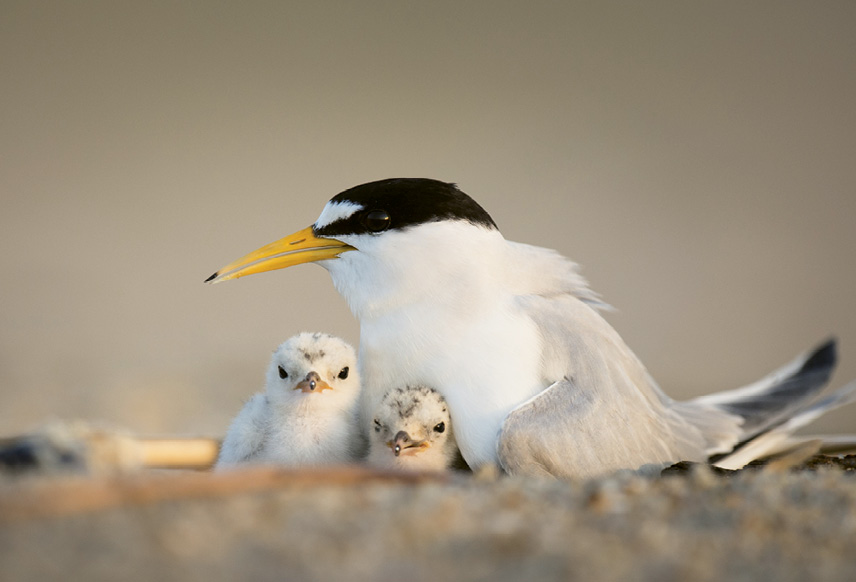
In the summer, tern chicks left alone for mere minutes can succumb to the scorching heat. Give them a better shot at survival by not disturbing birds on the beach. Learn more about seabirds at allaboutbirds.org.
Least Tern (Sterna antillarum)
Status: State threatened
The least tern is an elegant little aerialist in a black mask, no heavier than a lime and the smallest of our seabirds. Males glide through the salt air bearing tiny silver fish in their yellow beaks, each parading their catch before presenting it to a female. Like many shorebirds and seabirds, terns lay their eggs directly on the same sandy shorelines favored for recreation and development. Some have adapted to the disappearance of this habitat by forming nesting colonies on the next best thing—flat, pebble-covered rooftops—but overall, their numbers have steeply declined in recent years.
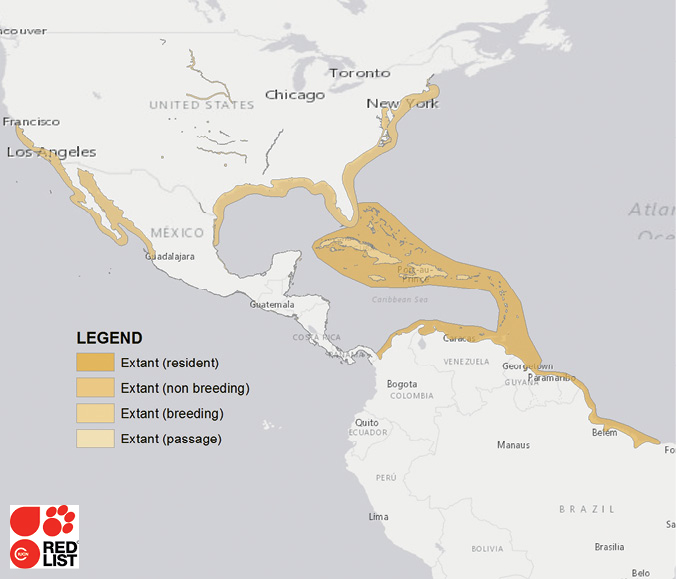
Range: Coastlines from US to northern South America, as well as along rivers in central US.
----------

Biologists at Bears Bluff National Fish Hatchery on Wadmalaw Island rear sturgeon for research and stocking purposes. Learn more at fws.gov /bearsbluff/.
Shortnose Sturgeon (Acipenser brevirostrum)
Status: State endangered and federally endangered
You could spend a lifetime fishing and boating the coastal rivers without ever encountering the elusive sturgeon—unless you happen to witness one jump. Sturgeon, which spawn in many of the state’s coastal rivers, have a peculiar and sometimes dangerous penchant for launching themselves out of water. The verdict is out on the exact purpose of these acrobatics; these ancient fish spend most of their time hovering across the riverbed, sucking up crabs, worms, and shellfish with thick, prehensile lips. The shortnose is the smaller of South Carolina’s two sturgeon species, but both are federally endangered after a century of overharvesting and habitat degradation depleted their population numbers.

Range: Large coastal rivers of eastern North America
------------

These birds might feign a broken wing to lure predators away from their chicks. Learn more at dnr.sc.gov/wildlife/species/coastalbirds.
Wilson’s Plover (Charadrius wilsonia)
Status: State threatened
The South Carolina coast plays host to dozens of shorebird species, but the Wilson’s plover is the rare year-round resident that makes its life and rears its young here—primarily on public beaches, including those of Folly, Kiawah, and Edisto. You’ll most often spot these birds near inlets as they alternate between scurrying across the beach and probing the sand for worms and small crabs. Between storms, sea level rise, predators, and human disturbance, there’s no shortage of forces that threaten the survival of these and other shorebirds, but there are also dedicated state biologists working hard to study and protect their preferred nesting sites.

Range: Coastlines from the mid-Atlantic to the Baja Peninsula to northern South America.
----------

Stripes, a female spotted turtle, is an education animal at the South Carolina Aquarium and an ambassador for her species. She was transferred as part of a breeding program with the Association of Zoos and Aquariums; The Turtle Survival Alliance supports turtle conservation across the globe but is based here in Charleston. Check out its work at turtlesurvival.org; Range: The Atlantic coastal lowlands and foothills from New England to northern Florida, as well as the Great Lakes region of Canada and the US and the upper reaches of the Ohio River system
Spotted Turtle (Clemmys guttata)
Status: State threatened
The petite spotted turtle (on average just 3½ to 4½ inches in length) is one of the few reptiles protected from collection and trafficking in South Carolina, but that hasn’t stopped poachers—the most significant threat to this rare turtle next to habitat loss. The reptile’s calm demeanor, unusual polka-dotted shells, and tendency to cluster in the breeding season make it a top target for pet trade collectors both legal and illegal. A number of poachers, sometimes repeat offenders, have been sentenced in recent years thanks to collaborative state and federal law enforcement stings. Spotted turtles typically inhabit boggy woodlands and are found across the Lowcountry and Midlands in South Carolina.
------------

Standing some three feet tall with a five-foot wingspan, an adult wood stork is the largest wading bird native to the US and the only stork to breed here.
American Wood Stork (Mycteria americana)
Status: State endangered and federally threatened
The large, bareheaded wood stork was once an oddity in South Carolina. But as wetlands were destroyed in southern Florida, the birds began shifting north, staking out new swamps for nesting grounds, including Lowcountry havens like Donnelley Wildlife Management Area. Their numbers have continued to grow in South Carolina, and these days, wood storks can commonly be spotted circling high over the coastline and plucking invertebrates from the salt marsh and cypress swamps. In 2014, after 30 years of conservation efforts, the species’ federal status was changed from “endangered” to “threatened.” And although the draining of wetlands remains a threat, biologists are optimistic about the wood stork’s future in the American Southeast.
Click here for more fun facts about this species.

Range: Coastal areas from South Carolina to southern South America
-------------

A massive right whale mama and her calf; Read more about these mammals at fisheries.noaa.gov/ species/north-atlantic-right-whale. Range: Once common on both sides of the North Atlantic, they’re now found primarily in the western North Atlantic, from winter calving grounds off Florida and Georgia to summering grounds in the Gulf of Maine, Bay of Fundy, Scotian Shelf, and Gulf of Saint Lawrence.
North Atlantic Right Whale (Eubalaena glacialis)
Status: Federally endangered
North Atlantic right whales rank as the world’s rarest marine mammals and among the largest animals ever to evolve on planet Earth, but superlatives are unlikely to reflect how awe-inspiring and imperiled these animals are. Right whales winter in South Carolina waters, mere passersby on their journeys to and from warmer calving grounds off Florida and Georgia. Unique calluses on the animals’ enormous heads allow biologists to recognize and track individuals. Experts fear for the future of these giants—approximately 450 remain—after several bleak seasons: birth numbers have been very low, and 2017 saw a devastating series of right whale deaths due to fishing gear entanglement and ship collisions.
------------

Despite their name, the birds are mostly black and white, with the males having a small red streak (“cockade”) behind the eye; Hurricane Hugo devastated the Francis Marion National Forest in 1989, killing many of its red-cockaded woodpeckers in the process. But it has since become a model for woodpecker recovery, with a robust population that now serves as a “donor” for other sites hoping to reintroduce this bird.
Red-Cockaded Woodpecker (Picoides borealis)
Status: State endangered and federally endangered
When John James Audubon visited the South’s vast longleaf pine forests in the early 1800s, he wrote that “at any time of the year, one is sure to be saluted by [the] peculiar note of the red-cockaded woodpecker.” That song had nearly disappeared some 150 years later, lost as the forests themselves were plundered for timber and resin. But some hope the worst is behind for these fierce little birds, which carve out their nests in the heartwood of living pines, thanks to decades of recovery and reintroduction efforts in places such as the Francis Marion National Forest.
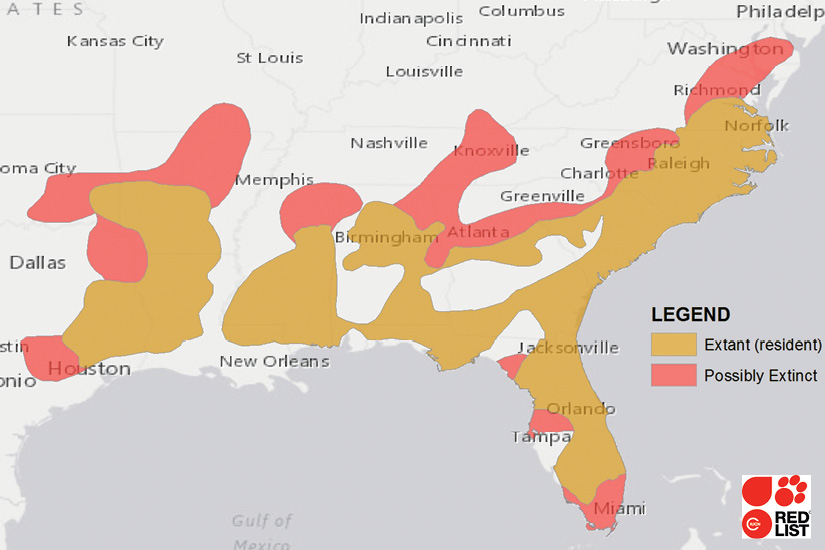
Range: Southeastern US.
------------

Plant butterfly milkweed in your yard. It’s native to the Lowcountry, adds a brilliant burst of orange to the garden, and is a monarch magnet. Learn more about how you can help these insects at xerces.org; Range: From Southern Canada and the entire US to Central America and most of South America; also present in Australia, Hawaii, and other Pacific Islands
Monarch Butterfly (Danaus plexippus)
Status: Under consideration for federal protection
Generations of Americans have marveled at the fact that an insect equipped with no more than a delicate set of wings can make one of the most mythic migrations in the animal kingdom. Monarchs fly up to thousands of miles south each fall to spend the winter in mountainous Mexican forests. But they’re also in trouble, facing threats from climate change and the loss of habitat and their host plant, milkweed, across North America. The monarchs we see in the Lowcountry typically do not make the trek to Mexico; many spend their winters here along the coast, and biologists are working quickly to better understand them so we ensure they continue to do so for generations to come.
And the Rest:
More local animals and plants that the South Carolina Department of Natural Resources and US Fish & Wildlife Service have listed as “at-risk” (AR), “threatened” (T), or “endangered” (E)
• Atlantic sturgeon (Acipenser oxyrinchus): E
• Bachman’s warbler (Vermivora bachmanii)): Likely extinct
• Black-capped petrel (Pterodroma hasitata): AR
• Blueback herring (Alosa aestivalis): AR
• Bog asphodel (Narthecium americanum): AR
• Boykin’s lobelia (Lobelia boykinii): AR
• Broad-striped dwarf siren (Pseudobranchus striatus): T
• Canby’s dropwort (Oxypolis canbyi): E
• Chaffseed (Schwalbea Americana): E
• Ciliate-leaf tickseed (Coreopsis integrifolia): AR
• Eastern black rail (Laterallus jamaicensis): AR
• Eastern diamondback rattlesnake (Crotalus adamanteus): AR
• Finback whale (Balaenoptera physalus): E
• Gopher frog (Lithobates capito): E
• Gopher tortoise (Gopherus polyphemus): E
• Green sea turtle (Chelonia mydas): T
• Humpback whale (Megaptera novaengliae): E
• Kemp’s ridley sea turtle (Lepidochelys kempii): E
• Kirtland’s warbler (Setophaga kirtlandii): E
• Leatherback sea turtle (Dermochelys coriacea): E
• MacGillivray’s seaside sparrow (Ammodramus maritimus macgillivraii): AR
• Northern long-eared bat (Myotis septentrionalis): T
• Piping plover (Charadrius melodus): T
• Pondberry (Lindera melissifolia): E
• Red knot (Calidris canutus rufa): T
• Seabeach amaranth (Amaranthus pumilus): T
• Tri-colored bat (Perimyotis subflavus): AR
• Venus flytrap (Dionaea muscipula): AR
Photographs (2) courtesy of South Carolina Aquarium; Range maps courtesy of IUCN (International Union for Conservation of Nature) Red List of Threatened Species™, iucnredlist.org; Photograph courtesy of US Fish & Wildlife Service; Photograph by Michael Durham; Photographs by (release) Ben Sumrell, A Natural Fact Photography; (Cape Romain) chris smith, Chris & Cami Photography; & (exam) Selimah Harmon; All courtesy of Avian Conservation Center; photograph by Allison Miller; Photograph by Mark Smith; Photographs (Frosted Elfin) courtesy of Nassau County Ralph E. Simmons State Forest & (Southern Hognose Snake) by Chris Mattison; Photographs (manatee) courtesy of savethemanatees.org & (Least tern) By Ray Hennessy Photographs by (shortnose sturgeon) Robert Michelson & (wilson’s plover) Gerald Marella